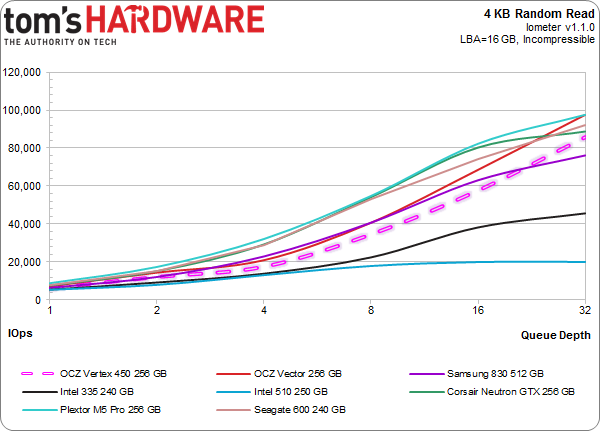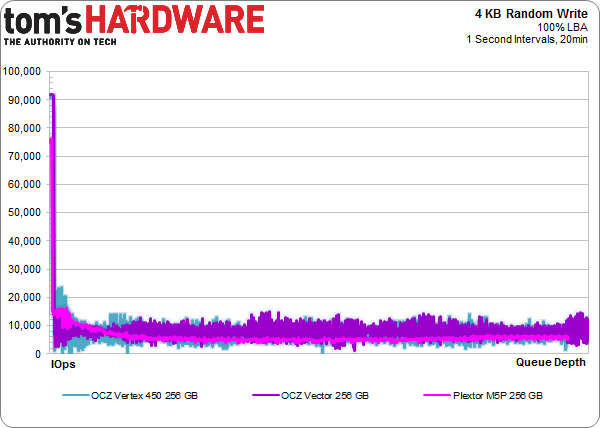OCZ Vertex 450 256 GB SSD Review: Can We Call It Vector Jr.?
OCZ is shaking up its current product stack by replacing the year-old Vertex 4 SSD. The Vertex 450 matches Barefoot 3 controller silicon with 20 nm synchronous NAND for something slightly more economical than the company's current flagship, the Vector.
Results: 4 KB Random Performance
Again, we turn to Iometer as our synthetic metric of choice for testing 4 KB random performance. Technically, "random" translates to a consecutive access that occurs more than one sector away. On a mechanical hard disk, this can lead to significant latencies that hammer performance. Spinning media simply handles sequential accesses much better than random ones, since the heads don't have to be physically repositioned. With SSDs, the random/sequential access distinction is much less relevant. Data can be put wherever the controller wants it, so the idea that the operating system sees one piece of information next to another is mostly just an illusion.
4 KB Random Read
The Plextor, Seagate, and Corsair drives, all of which employ either 24 or 19 nm Toggle-mode NAND, regulate the field through a queue depth of 16. They're not matched until we push 32 commands concurrently.
OCZ's two drives fall into the middle of the pack, ahead of Intel's SSDs, but behind the three aforementioned models. It isn't until we hit a queue depth of 32 that the Vector and Vertex 450 pick up steam. At that point, the Vector puts 12,000 IOPS on the Vertex 450. With only a handful of outstanding commands, however, the delta is minimal. OCZ's Vertex 450 is rated for 85,000 4 KB random read IOPS, and we get slightly more.
4 KB Random Write
Roughly 10,000 IOPS separate the Vertex 450 from the Vector, but only at a queue depth of four. Everywhere else, the two drives perform virtually identically. Both SSDs are capable of writing faster at lower command counts than the other tested drives, though the entire field catches up at a queue depth of 32.
The Vector and Vertex 450 might have different names, but at least thus far, they aren't distinguishing themselves many other ways. After two 128 KB sequential writes across the entire LBA space, writing 4 KB blocks at a queue depth of 32 for multiple hours reveals the two SSDs as near-twins. The Vector is slightly faster and the Vertex 450 is slightly slower. Representing more familiar drives is Plextor's M5 Pro.
Get Tom's Hardware's best news and in-depth reviews, straight to your inbox.
When we look at one-minute intervals, all three SSDs behave similarly. The Vector is still the quickest, but the Vertex 450 is consistently about 12% behind. Meanwhile, the Plextor manages fewer IOPS minute after minute. All three drives boast the same amount of flash, the same accessible space, and the same ratio of over-provisioning.
If we instead log at one-second intervals, not much changes except that the Plextor SSD exhibits a lower coefficient of variation. It's basically razor flat after shelving off what little space remains on a completely filled drive. The two OCZ models are quicker overall, though the spike higher and drop lower as they sort out their garbage collection situations.
None of these charts effectively show what's happening behind the scenes. In what is probably no coincidence at all, both Indilinx-based SSDs look a lot like the Marvell-powered Vertex 4 the Vertex 450 is supposed to replace. Clearly, we need some additional testing in order to help answer our questions.
Current page: Results: 4 KB Random Performance
Prev Page Results: 128 KB Sequential Performance Next Page Optimizing Performance, Like Vertex 4-
boulbox Kinda wanted to see 840 pro match up with it too. Guess it doesn't really matter since we could just go find your other benchies on it and compare it ourselves but i thought it would just be nice to have it up there.Reply -
Faisal Mahmood Speed and performance are fine but what really counts is reliability which OCZ does not have. I had to RMA Vertex 2 twice and both times it lasted 8 months. Before that I invested in an Intel x25-m and it is still going strong.Reply -
s3anister Just bought another 840 Pro. Really can't trust OCZ anymore after so many failed Vertex 3s.Reply -
slomo4sho It is pretty common to find quality SSDs in the $0.55-0.65/GB range these days. Game coupon aside, the price of this SSD isn't all that competitive.Reply -
technerd Faisal MahmoodSpeed and performance are fine but what really counts is reliability which OCZ does not have. I had to RMA Vertex 2 twice and both times it lasted 8 months. Before that I invested in an Intel x25-m and it is still going strong.SAME! I'm going to Samsung for my next SSD. OCZ's reliability is a jokeReply
-
kitsunestarwind I love OCZ The Vertex4 series SSDs have been nothing but rock solid reliable, much better then their earlier offerings and the problems with the Vertex2/3 series drivesReply -
cryan slomo4shoIt is pretty common to find quality SSDs in the $0.55-0.65/GB range these days. Game coupon aside, the price of this SSD isn't all that competitive.Reply
The Vector gets the Far Cry 3 coupon until July 14th while the Vertex 450 doesn't get it at all. If you're having to choose between the two, the Vector is probably the better bet unless the V450 is significantly cheaper. It's hard to say what the Vertex 450 will cost once generally available, but it'd be prudent to expect prices to be higher for the first few weeks. Initially, the Vertex 450 will probably be near the $235 mark, only a few bucks less than the Vector (about $15). Is it worth giving up two years of warranty and a FC3 coupon to save $15? You be the judge.
Regards,
Christopher Ryan
-
cryan boulboxKinda wanted to see 840 pro match up with it too. Guess it doesn't really matter since we could just go find your other benchies on it and compare it ourselves but i thought it would just be nice to have it up there.Reply
Stay tuned, because we're working on it. I've been rebuilding the entire database of comparative consumer SSD performance data, and some drives haven't been done yet for one reason or another. In some cases, it's due to time constraints. In other cases, acquiring or reacquiring particular SSDs has been problematic.
Regards,
Christopher Ryan
-
dgingeri I'd like to see it's relative performance compared to a Vertex 4. I have two Vertex 4 drives, a 256 and a 128, and I've been wondering how these new drives would compare, and if they're worth spending the money to swap with my Vertex drives.Reply -
raidtarded Later in its life, the Vertex 4 shipped with Micron NAND, eschewing Intel's flash for a slight performance drop and better pricing.Reply
Doesn't Intel and Micron use the same NAND via the IMFT partnership?



